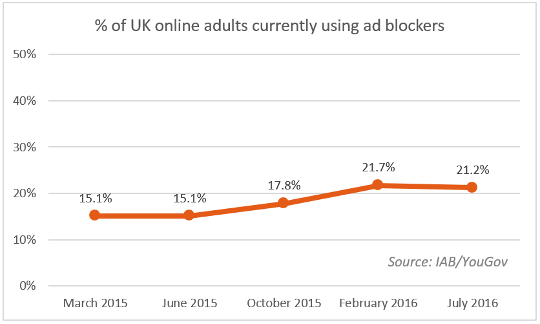While display advertisers trawl for a resolution to the “growing” usage of tools that block their inventory, new research suggests the problem may have already peaked.
New figures from IAB UK and YouGov has found that although 21.2% of users arm their devices with ad blockers, that figure has slipped ever so slightly from the 21.7% reported in February. News of the latter created panic among publishers and ad servers as rates of adoption rose from 15.1% in March 2015.
In a highly intriguing spin, the IAB also found that as many as one in five were confusing the filter with anti-virus software or cited ad blockers that don’t exist. This means that the levels of people using ad blockers might in fact be lower than the reported 21% in July.
But the problem is far from over, according to IAB UK’s CEO, Guy Phillipson.
“It’s encouraging to see ad blocking plateauing but it certainly isn’t a sign the industry needs to take its foot off the pedal in terms of moving to a less invasive, lighter and more user-friendly ad experience,” he commented.
Positive readings
YouGov’s survey of 2,011 British adults has revealed that after months of increases, rates of ad blocking have now plateaued.
Ad blockers are still most common among 18-24-year-olds (38%) and half of the users (50%) choose Europe’s most popular tool, Adblock Plus.
Otherwise, the results paint a good picture for those expressing worry about how big the trend could get. It’s believed that 22% of ad-blocking users no longer have their tool running, while 55% said they would switch it off if this prevented them from accessing content.
Sites including the Financial Times and Bild have trialled similar activities in their fight against ad blockers, alerting users to their harm on revenue and the knock-on effect this has on their experience.
Reasons remain
The main reason for ad blocking is still a lack of trust, which has grown stronger in the last quarter, jumping up from 6% in February to 14% in July, and is particularly common among women (27% as compared to 4% among men).
But as the issue reaches a crucial phase in its development, Phillipson believes the “value exchange” message may be gaining stronger traction.
The majority of users (67%) are aware of the fact content is often funded by online ads, while half of them (55%) know that without advertising content could not be free.
Almost a fifth (18%) declared they’re “less likely” to use ad blockers in the future if the alternative is websites start charging for their content, which could make for an interesting situation if sites go down this route.


